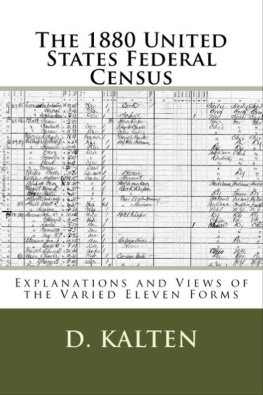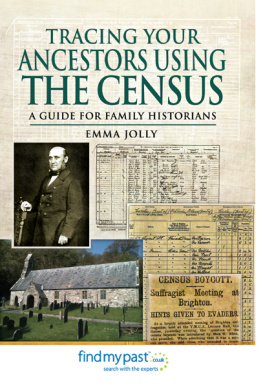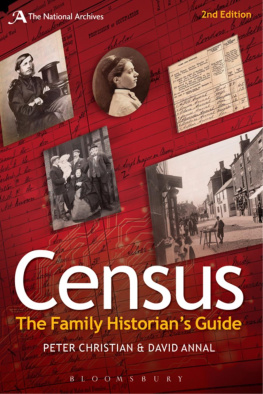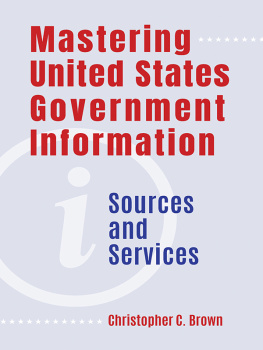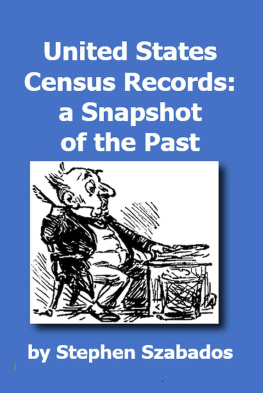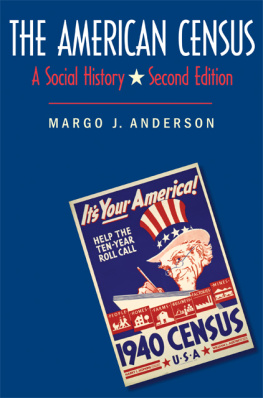The 1880 United States Federal Census
Explanations and Views
of the
Varied Eleven Forms
.
D. Kalten
Copyright
The 1880 United States Federal Census
Explanations and Views of the Varied Eleven Forms
2015 D. Kalten. All Rights Reserved.
Introduction
T he U. S. government census records are questionnaires. Each census asks for names and facts for a variety of personal information. Questions can vary from one census to another, as you probably know.
The Federal United States Census for the year of 1880 has more to it than just the page you will find easily. There are other forms beyond the main form and few people realize that more information is available for their ancestors. Unfortunately many of the pay and free on-line sites show you only the main form and they do not hint that more information survives. Most people do not know that more information exists so they are happy with what they found and move on, missing a lot.
This book explains the different 1880 Federal United States Census forms and gives you information about each. You will see the instructions given to the enumerators and the questions asked of each household for each different form. You will also see a sample of each form.
If you have already done research for family members within the 1880 census, after reading this book, you will want to find what you have missed. If you are planning on doing research for the year of 1880, be sure to read this book first.

Table of Contents
I ntroduction
Table of Contents
Chapter One. Explaining the Forms
Chapter Two. Enumerators and Duties
ENUMERATORS
DUTIES OF ENUMERATORS
INDIANS
Chapter Three. Schedule 1
Enumerator Instructions concerning Dwelling Houses:
Enumerator Instructions concerning Families:
Enumerator Instructions concerning Names:
Enumerator Instructions concerning Personal Description:
Enumerator Instructions concerning Occupation
Enumerator Instructions concerning Place of Birth:
Enumerator Instructions concerning Civil Divisions:
Enumerator Instructions concerning Numbering Pages:
Enumerator Instructions concerning Streets and Street Numbers in Cities:
The instructions at the top of the Census
The areas that were to be filled out at the top of the form were
The questions asked were:
Chapter Four. Supplemental Schedule 2
Chapter Five. Supplemental Schedule 3
Chapter Six. Supplemental Schedule 4
Chapter Seven. Supplemental Schedule 5
Chapter Eight. Supplemental Schedule 6
Chapter Nine. Supplemental Schedule 7
Chapter Ten. Supplemental Schedule 7A
Chapter Eleven. Schedule 2
Chapter Twelve. Schedule 3
Chapter Thirteen. Mortality Schedule
Chapter Fourteen. Finding Originals
A note from the author:
N OTES: _____________________________________________
____________________________________________________
____________________________________________________
____________________________________________________
____________________________________________________
____________________________________________________
____________________________________________________
____________________________________________________
____________________________________________________
____________________________________________________
Chapter One. Explaining the Forms
T he 1880 Federal Census was the tenth Federal United States Census, the first being done in 1790. The census began on the first day of June 1880 and was to be completed within thirty days. For areas with populations over 10,000 it was to be completed within two weeks. All information entered was to be as things were on or prior to the date of June 1, 1880. If something changed on June 2, it was not to be included.
Arrangement of the Census in microfilms is by the Enumeration District, often called the ED. This would be the area that one census taker could cover for the census.
When this census was completed, it showed that there were 50,189,209 residents in the country. The previous census of 1870 showed 39,818,449 residents.
...
Counting the main Federal census form, there were ten varied census forms for 1880. Another form to look at is the Mortality Schedule making the total forms eleven.
There were seven various supplemental forms connected to the main 1880 Federal census that many people are not aware of. These census forms fall under different classes and contained detailed information. Added forms were for the Insane, the Idiots, Deaf-Mutes, the Blind, Homeless Children, Prisoners and Paupers, and Indigent people. These are commonly known as the Social Statistic Schedules. There were also the Agriculture, Manufacturing, and then the Mortality Schedules.
Schedules in the 1880 census were also known as the Decennial Census, those schedules being Agriculture, Manufacturing, Mortality, Population, and Social Statistics.
...
Each of the schedules was given a schedule name described as following.
(1) The MAIN Census, Schedule 1.
(2) INSANE:
1880 Supplemental Schedule 2, for the Defective, Dependent, and Delinquent Classes - INSANE.
(3) IDIOTS:
1880 Supplemental Schedule 3, for the Defective, Dependent, and Delinquent Classes IDIOTS.
(4) DEAF-MUTES:
1880 Supplement Schedule 4, for the Defective, Dependent, and Delinquent Classes DEAF-MUTES.
(5) BLIND:
1880 Supplement Schedule 5, for the Defective, Dependent, and Delinquent Classes BLIND.
(6) HOMELESS CHILDREN:
1880 Supplement Schedule 6, for the Defective, Dependent, and Delinquent Classes HOMELESS CHILDREN.
(7) PRISONERS:
1880 Supplement Schedule 7, for the Defective, Dependent, and Delinquent Classes INHABITANTS IN PRISON.
(8) PAUPER and INDIGENT:
1880 Supplement Schedule 7 [7A], for the Defective, Dependent, and Delinquent Classes PAUPER AND INDIGENT.
The above supplemental forms have been referred to as the DDD Census, meaning Defective, Dependent and Delinquent.
(9) AGRICULTURAL CENSUS. If your family member is listed as a farmer on the main census schedule, you do want to check this for further information concerning the person.
(10) MANUFACTURING. If your family member is shown owning a business connected to manufacturing, you do want to check this for further information concerning the person.
(11) MORTALITY. If you had a family member who died during the previous year, you do want to see this form.
...
Chapter Two. Enumerators and Duties
ENUMERATORS
E ach enumerator was "to visit personally each dwelling house in his sub-division, and each family therein, and each individual living out of a family in any place of abode, and by inquiry made of the head of such family, or of the member there of deemed most credible and worthy of trust, or of such individual living out of a family, to obtain each and every item of information and all the particulars." In case no one was available at a family's usual place of abode, the enumerator was directed by the law "to obtain the required information, as nearly as may be practicable, from the family or families, or person or persons, living nearest to such place of abode."
...
DUTIES OF ENUMERATORS
I t is by law made the duty of each enumerator, after being duly qualified as above, to visit personally each dwelling in his subdivision, and each family therein, and each individual living out of a family in any place of abode, and by inquiry made to the head of such family, or of the member hereof deemed most credible and worthy of trust, or of such individual living out of a family, to obtain each and every item of information and all the particulars required by the act of March 3, 1879, as amended by act of April 20, 1880.
Next page
